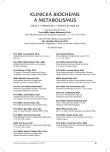-
Medical journals
- Career
Interpretation difficulties in electrophoresis and immunofixation findings in patients with multiple myeloma after autologous transplantation
Authors: P. Kušnierová 1,2; D. Zeman 1,2; R. Šigutová 1,2; Z. Švagera 1,2; L. Zahradová 3,4; R. Hájek 3,4
Authors‘ workplace: Ústav laboratorní diagnostiky, Oddělení klinické biochemie, Fakultní nemocnice Ostrava 1; Katedra biomedicínských oborů, Lékařská fakulta, Ostravská univerzita 2; Klinika hematoonkologie, Fakultní nemocnice Ostrava 3; Katedra interních oborů, Lékařská fakulta, Ostravská univerzita 4
Published in: Klin. Biochem. Metab., 25, 2017, No. 2, p. 59-63
Overview
Objective:
The study of abnormal gradients including new monoclonal immunoglobulins and oligoclonal bands in patients with multiple myeloma after autologous transplantationDesign:
Retrospective study.Material and Methods:
100 multiple myeloma patients after autologous transplantation between November 2013 and August 2016 from the Clinic of Haematooncology, University Hospital Ostrava, were included in the study. For the identification and quantification of paraproteins, standard serum protein electrophoresis and immunofixation electrophoresis were used. Exceptionally, in case of equivocal results, agarose isoelectric focusing with subsequent affinity-mediated immunoblotting was performed.Results:
Changes in immunofixation result were observed 2 months (mean; range 1-8 months) after the autologous transplantation in 46 % of patients. In 6 (13%) of them isotype switch was observed, in 17 (37 %) transient oligoclonal profile, and in 23 (50 %) isotype shift as well as transient oligoclonal profile. Return towards the original immunofixation result was observed 14 months (mean; range 4-32 months) after the autologous transplantation.Conclusion:
Observation of new monoclonal gradients or transient presence of oligoclonal bands in patients after autologous transplantation probably represents a transient phenomenon linked to the recovery of immunoglobulin production without any negative clinical significance in sense of a disease relapse.Keywords:
serum protein electrophoresis, immunofixation electrophoresis, isoelectric focusing, monoclonal immunoglobulin, oligoclonality, multiple myeloma.
Sources
1. Mitus, A. J., Stein, R., Rappeport, J. M. Antin, J. H., Weinstein, H. J., Alper, C. A., Smith, B.R. Monoclonal and oligoclonal gammopathy after bone marrow transplantation. Blood, 1989, 74, p. 2764–2768.
2. Gerritsen, E. J. A., Van Tol, M. J. D., Lankester, A. C., van der Weijden-Ragas, C. P. M., Jol-van der Zijde, C. M., Ouderman-Gruber, N. J., Radl, J., Vossen, J.M. Immunoglobulin levels and monoclonal gammopathies in children after bone marrow transplantation. Blood, 1993, 82, p. 3493–3502.
3. Gerritsen E. J. A. Van Tol, M. J. D., Van’t Veer, M. B., Wels, J. M. A., Khouw, I. M. S. L., Touw, C. R., Jol-van der Zijde, C. M., Hermans, J., Rumke, H. C., Radl, J., Vossen, J. M. Clonal dysregulation of the antibody response to tetanus-toxoid after bone marrow transplantation. Blood, 1994, 84, p. 4374-4382.
4. Zent, C. S., Wilson, C. S., Tricot, G., Jagannath, S., Siegel, D., Desikan, K. R., et al. Oligoclonal protein bands and Ig isotype switching in multiple myeloma treated with high-dose therapy and hematopoietic cell transplantation. Blood, 1998, 91, p. 3518–3523.
5. Maisnar, V., Tichý, M., Smolej, L., Zák, P., Radocha, J., Palička, V., Malý, J., Bláha, V. Isotype class switching after transplantation in multiple myeloma. Neoplasma, 2007, 54(3), p. 225-228.
6. Hall S. L., Tate, J., Gill, D., Mollee, P. Significance of abnormal protein bands in patients with multiple myeloma following autologous stem cell transplantation. Clin. Biochem. Rev., 2009, 30, p. 113-118.
7. Hovenga, S., de Wolf, J. T., Guikema, J. E., Klip, H., Smit, J. W., Smit Sibinga, C. T. Autologous stem cell transplantation in multiple myeloma after VAD and EDAP courses: a high incidence of oligoclonal serum Igs post transplantation. Bone Marrow Transplant., 2000, 25, p. 723–728.
8. Guikema, J. E., Vellenga, E., Veeneman, J. M., Hovenga, S., Bakkus, M. H., Klip, H., et al. Multiple myeloma related cells in patients undergoing autologous peripheral blood stem cell transplantation. Br. J. Haematol., 1999, 104, p. 748–754.
9. Sindic, C. J., Laterre, E. C. Oligoclonal free kappa and lambda bands in the cerebrospinal fluid of patients with multiple sclerosis and other neurological diseases. An immunoaffinity-mediated capillary blot study. J. Neuroimmunol., 1991, 33, p. 63-72.
10. Zeman, D., Vaníčková, Z., Benáková, H., Havrdová, E. Volné lehké řetězce typu kappa v likvoru a seru. Klin. Biochem. Metab., 2002, 10(31), p. 98-102.
11. Nováčková, L., Zeman, D. Detection of oligoclonal IgG bands in cerebrospinal fluid and serum: comparison between commercial immunofixation method and homemade affinity immunoblotting method and evaluation of interobserver agreement. Klin. Biochem. Metab., 2011,19(40), p. 229-233.
12. Zeman, D., Hradílek, P., Kušnierová, P. et al. Oligoclonal free light chains in cerebrospinal fluid as markers of intrathecal inflammation. Comparison with oligoclonal IgG. Biomed. Pap. Med. Fac. Univ. Palacky Olomouc, Czech Repub. 2015, 159, p. 104-114.
Labels
Clinical biochemistry Nuclear medicine Nutritive therapist
Article was published inClinical Biochemistry and Metabolism

2017 Issue 2-
All articles in this issue
- Laboratory aspects of systemic AA amyloidosis
- MedPed project in Czech Republic
- Interpretation difficulties in electrophoresis and immunofixation findings in patients with multiple myeloma after autologous transplantation
- External quality evaluation programs at the time of harmonizing laboratory results
- 23 cases of Metformin-induced Metabolic Lactic Acidosis in Patients treated with Metformin
- Exercise-induced rhabdomyolysis – frequent cause of false diagnosis
- Clinical Biochemistry and Metabolism
- Journal archive
- Current issue
- Online only
- About the journal
Most read in this issue- Exercise-induced rhabdomyolysis – frequent cause of false diagnosis
- 23 cases of Metformin-induced Metabolic Lactic Acidosis in Patients treated with Metformin
- MedPed project in Czech Republic
- Interpretation difficulties in electrophoresis and immunofixation findings in patients with multiple myeloma after autologous transplantation
Login#ADS_BOTTOM_SCRIPTS#Forgotten passwordEnter the email address that you registered with. We will send you instructions on how to set a new password.
- Career

